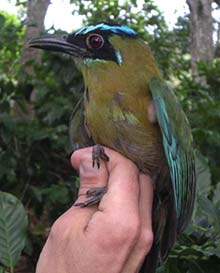Does shade coffee help or hinder conservation?

Blue-Crowned Motmot - one of the many bird species that depend on tropical forests in coffee farming regions <br>-- Photo: Thomas Dietsch
Labeled “bird-friendly” but may accelerate tropical forest clearing
While shade coffee is promoted as protecting tropical forests and birds, conservationists are split on whether it actually works. The December issue of Conservation Biology has the latest on the debate: one side says shade coffee can give farmers a reason to preserve tropical biodiversity while the other side fears it can actually encourage farmers to clear more forest.
Shade coffee is a traditional farming method of growing coffee bushes under a canopy of diverse trees, which helps protect the many bird species that depend on them.
The case for shade coffee is argued by Stacy Philpott of the University of Michigan in Ann Arbor and Thomas Dietsch of the Smithsonian Migratory Bird Center in Washington DC, who say the keys to making it work are requiring rigorous certification and offering financial incentives. “Without incentives, and faced with economic hardship, farmers may convert their lands to sun coffee, pasture or swidden agriculture, requiring that they cut more forest,” they say.
Philpott and Dietsch say that there are currently two rigorous shade certification programs (Bird-friendly Coffee from the Smithsonian Migratory Bird Center, and Eco-OK from the Rainforest Alliance) that require a diverse canopy over coffee farms. However, these programs are not widely used by small coffee farmers in part because they can be expensive.
To encourage more farmers to continue growing shade coffee instead of switching to less conservation-friendly types of agriculture, Philpott and Dietsch advocate linking shade certification with fair-trade certification. The latter has the advantages of covering the costs of farm visits, and of helping small farmers make a living by offering price premiums and loans. “Unless shade standards are linked to price premiums for coffee producers…these programs will ultimately fail…when farmers face the choice of clearing forest or starvation,” they say.
To make shade certification programs stronger, Philpott and Dietsch also recommend giving coffee farmers financial incentives to maintain biodiversity-rich shade farms and to preserve adjacent forest fragments. Finally, to help keep farmers from converting more forest to shade coffee, they recommend only certifying farms that are 10 or more years old.
The case against shade coffee is argued by John Rappole of the Smithsonian Conservation and Research Center in Front Royal, Virginia; David King of the U.S. Forest Service Northeast Experiment Station at the University of Massachusetts in Amherst; and Jorge Vega Rivera of the Instituto Biologia in San Patricio, Mexico.
While shade certification sounds good in theory, Rappole and his colleagues say that it does not always work in practice. “Currently, promotion far outstrips certification,” they say, noting that several retailers claim their coffee is shade-grown and bird-friendly but lack rigorous certification programs. The problem is that simply being grown in the shade is not enough to make coffee bird-friendly. Besides the traditional farms where shade is provided by a diverse canopy, there are also multi-crop coffee farms where shade is provided by cacao and a few other economically valuable trees.
Because shade certification is not necessarily rigorous, offering economic incentives for shade coffee could encourage farmers to clear more forest, say Rappole and his colleagues. They have seen extensive areas of native forest replaced by low-diversity, multi-crop shade coffee farms during their years of fieldwork in Mexico and Central America. “I have worried for a long time that shade coffee promotion could have unintended consequences,” says Rappole.
CONTACT:
Stacy Philpott: 734-764-1446, sphilpot@umich.edu)
Thomas Dietsch: 202-673-4790, dietscht@nzp.si.edu)
John Rappole: 540-635-6537, (jrappole@cres.si.edu)
Media Contact
All latest news from the category: Ecology, The Environment and Conservation
This complex theme deals primarily with interactions between organisms and the environmental factors that impact them, but to a greater extent between individual inanimate environmental factors.
innovations-report offers informative reports and articles on topics such as climate protection, landscape conservation, ecological systems, wildlife and nature parks and ecosystem efficiency and balance.
Newest articles

Superradiant atoms could push the boundaries of how precisely time can be measured
Superradiant atoms can help us measure time more precisely than ever. In a new study, researchers from the University of Copenhagen present a new method for measuring the time interval,…

Ion thermoelectric conversion devices for near room temperature
The electrode sheet of the thermoelectric device consists of ionic hydrogel, which is sandwiched between the electrodes to form, and the Prussian blue on the electrode undergoes a redox reaction…

Zap Energy achieves 37-million-degree temperatures in a compact device
New publication reports record electron temperatures for a small-scale, sheared-flow-stabilized Z-pinch fusion device. In the nine decades since humans first produced fusion reactions, only a few fusion technologies have demonstrated…





















